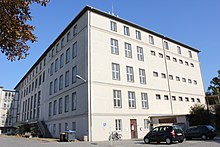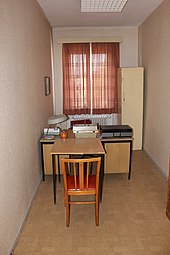Bautzner Strasse memorial in Dresden
The Bautzner Strasse Dresden memorial is a memorial for the victims of the GDR - Ministry for State Security (MfS) in the Saxon state capital Dresden . It is the only remand prison of the "Stasi" in the Free State that has been preserved in the original and is accessible to visitors . Both the side of the former prisoners on remand as well as that of the former MfS employees are thematized in the exhibition. The memorial is supported by the association "Knowledge through Remembrance eV".
Location
The memorial is located on the former area of the district administration (BV) of the MfS. The western part of the BV was in the Neustadt district, the eastern and much larger part in Loschwitz . The remand prison, which can still be visited today, the multi-purpose hall with offices and the Soviet cellar are located in the building complex at Bautzner Strasse 112a. The area in the vicinity of the Waldschlösschenviertel is now part of the statistical district of Radeberger Vorstadt and thus part of the Neustadt district . The area is bounded in the north by Bautzner Straße (B6) and in the south by the Dresden Elbe slopes that gradually run out here . The Elbe itself flows 200 meters south of the memorial. The Waldschlößchenbrücke is 400 meters downstream.
Exhibitions
In the memorial, many rooms of the former remand prison are presented, which have largely been preserved in their original state since 1989. These include the »storage rooms«, detention and shower rooms, writing cell, recording and photo room, an interrogation room, the outdoor area and a vehicle lock with standing cells. The so-called “Fuchsbau”, the former cellar of the Soviet secret service, can also be seen as part of the permanent exhibition “From the Dresden cellar prison to the camp”. In addition to reconstructed cellar cells, various individual fates of political prisoners from the Soviet occupation zone (SBZ) and early GDR as well as the effects of imprisonment on their families and friends are on display. Since 2019 it has been possible to borrow an audio guide on this topic. Contemporary witnesses have spoken their memories for this.
In May 2014, parts of the former MfS district administration including the Stasi ballroom as well as the premises of the last head of the district administration, Major General Horst Böhm, were added . Audio installations with original sound recordings by MfS employees are set up in these rooms.
Several permanent exhibitions are shown in the detention center. Among other things, exhibitions on the individual fates of political prisoners and interrogation methods of the MfS are presented, which have also been supplemented by interviews with contemporary witnesses at media stations since June 2014. There are also exhibition modules on the persecution of students critical of the regime at universities in Saxony , on the emigration of the Prague embassy refugees through the GDR to the Federal Republic of Germany in October 1989, and an exhibition on the peaceful occupation of the Dresden district administration on December 5, 1989. The exhibition Wendeseiten enables a multimedia book to understand the last months of the GDR.
history
After the end of the Second World War , the Soviet secret service - parallel to the remand prison at Münchner Platz - used basement rooms in the north of Dresden, including on Fabricestrasse, Magazinstrasse, Königsbrücker Strasse and Zittauer Strasse. The cellars of two villas on the site of what would later become BV Dresden were also furnished for this purpose.
The so-called Heidehof, directly on Bautzner Strasse, served as an early remand prison. The Heidehof - originally a paper and cardboard factory built in 1882, later a residential building - first had to be restored after damage as a result of the bombing raids in February 1945, so it is currently assumed that it will be used from 1949.
Thousands of real and alleged Nazi and war criminals, as well as people who were critical of the new regime in the Soviet Zone, were held in the basement prison and sentenced to death or to work in the Soviet Gulag by an SMT . Others were interned in the special camps in the Soviet Zone / GDR without judgment .
In October 1953, the SfS / MfS moved from Königsbrücker Straße to the site on the Elbe slope and thus took over the area from the Soviet authorities. Immediately afterwards, the MfS had the multi-purpose hall with the attached new detention center built in a U-shape. This was the first MfS-owned new building of a remand prison in the GDR area. In the period from 1950 to 1989, it can be assumed that there were around 10,000 GDR citizens who were held in MfS underground custody in the Dresden district. They were mostly political prisoners. People who wanted to exercise the human and civil rights that we take for granted today. In the early days, between 1950 and 1967, there were often protests against the situation in the GDR ("agitation," "boycott," "propaganda"), oppositional behavior ("espionage / agent activity", "resistance / violence against the police") , Contact with Western organizations) as well as "escape from the republic" to start an investigation with custody. In the 1970s and 1980s, it was primarily the criminal offenses that were related to flight and departure. The prison conditions were inhumane by today's standards, and the psychological stress on the inmates from the prison regime and interrogations was high. For many, the feeling of being at the mercy set in. There were no constitutional standards. It was the primacy of SED policy.
The entire area of the BV Dresden was about 3.5 hectares. The detention center was only a small part. During the period of use from 1953 to 1989, the Dresden Chekists had various office and functional buildings (cafeteria, medical service, (weapons) warehouse, archive building, garages, workshops) built. The KD Dresden-Stadt was also on the site. The KD Dresden-Land on the other side of Bautzner Strasse. The "technical complex" built in the 1970s with various workshops, warehouses and a washing facility was located on Fischhausstrasse. In autumn 1989 around 2,600 employees worked in and around the area, 3,591 employees in the entire Dresden district.
On December 5, 1989, four weeks after the fall of the Berlin Wall , demonstrators occupied the building complex without violence and stopped the previously started destruction of the Stasi documents from the district administration and the MfS district offices. In addition to the found materials, they also secured the inventory. Political prisoners were no longer in the cell house at this point.
The undestroyed or partially destroyed files were then stored in the prison cells, which were retained in their former condition due to the change in power in the building. This protected them from further destruction and unauthorized access. After German reunification in 1990, the Dresden branch of the Federal Commissioner for the Records of the State Security Service of the Former German Democratic Republic (BStU) moved into the building complex and began analyzing the Stasi records. In the summer of 1993, the authority moved to Riesaer Strasse in Pieschen , where it can still be found today. From 1991 to 2007 the vocational school center for health and social affairs used parts of the area, especially the old Heidehof. The former MfS cafeteria has been converted into a discotheque.
The prison has been a listed building since 1994 . The sponsoring association “Knowledge through Remembrance”, newly founded in 1997, and the Saxon Memorials Foundation to commemorate the victims of political tyranny began in the same year to open up the facility to the public and to set up a permanent memorial. To this day, the association controls the fortunes of the memorial. The former Lord Mayor of Dresden, Dr. Herbert Wagner .
Between March and June 2006, »Extension Building 2« on the street front, built in the 1980s, was demolished. The seven-storey block of type WBS 70 with over 190 offices and a former guardhouse had the intended connection of Waldschlößchenbrücke the Bautzner road soft. The cafeteria was demolished in 2015.
From March 2007 to February 2008, the detention center was renovated under the conditions of monument protection and largely preserved in the original. The former detention kitchen was converted into a cafeteria and exhibition areas were created. As part of the expansion of the memorial in May 2014, an information and advice center of the BStU was set up in the memorial's house.
literature
- Agathe Conradi: From a place of repression to a place of remembrance: The emergence of the Bautzner Strasse Dresden memorial, unpublished master's thesis at the TU Berlin from 2016.
- Citizens Committee Bautzner Strasse e. V .: MfS district administration Dresden - an initial analysis -. 1st edition. Citizens Committee Bautzner Strasse e. V., Dresden 1992.
- Heiko Neumann: "And then they somehow broke my will.": Detention regime & interrogation practice in the MfS U-Haft Bautzner Strasse Dresden 1953–1989. 1st edition. Bautzner Straße Memorial Dresden, Dresden 2016, ISBN 978-3-98164-213-1 .
- Uljana Sieber, Katrin Thiel: Dresden, Bautzner Strasse. From the political prison to the place of the Peaceful Revolution ("Places of History"). 1st edition. Ch. Links Verlag, Berlin 2017, ISBN 978-3-86153-927-8 .
- Uljana Sieber, Bautzner Straße Memorial Dresden (ed.): "Concerns II. Understanding the past - taking the future into your hands!". Book on the school project of the same name and the exhibition in the former Soviet cellar of the Bautzner Straße memorial in Dresden . 1st edition, Bautzner Strasse Memorial, Dresden 2014, ISBN 978-3-9816421-1-7 .
- Annette Weinke , Gerald Hacke: custody on the Elbe slope. The pre-trial detention center of the district administration of the Ministry for State Security in Dresden 1945 to 1989/1990 (= series of publications by the Saxon Memorials Foundation in memory of the victims of political tyranny. Vol. 9). Sandstein, Dresden 2004, ISBN 3-937602-15-1 .
- Local association Loschwitz-Wachwitz eV (ed.): Loschwitz: Illustrated local history 1315–2015, Dresden 2016.
Web links
Individual evidence
- ↑ Uljana Sieber: "Concerns II. Understanding the past - taking the future into your hands!" : Book on the school project of the same name and the exhibition in the former Soviet cellar of the Bautzner Straße memorial in Dresden . Ed .: Bautzner Strasse Memorial. 1st edition, Bautzner Strasse Memorial, Dresden 2014, ISBN 978-3-9816421-1-7 .
- ↑ Heiko Neumann: "And then somehow they broke my will." : Detention regime & interrogation practice in the MfS-U-Haft Bautzner Straße Dresden 1953 - 1989 . Ed .: Bautzner Strasse Memorial. 1st edition. Dresden, ISBN 978-3-9816421-3-1 .
- ↑ Jens Gieseke: The full-time employees of the Ministry for State Security . Ed .: BStU. Anatomy of the State Security History, Structure and Method. MfS manual, part IV / 1. Berlin 1996, p. 101 .
- ^ Sächsische Zeitung: The first new school is being built since the fall of the Wall. Vocational school center for health and social affairs moves. Ed .: Saxon Newspaper. Dresden December 11, 2003.
- ↑ Bautzner Strasse Memorial: Knowledge through memory. Retrieved July 24, 2020 .
- ↑ Knowledge through memory: Annual report 2019. In: https://www.bautzner-strasse-dresden.de/ . Knowledge through Memory, 2020, accessed July 24, 2020 .
Coordinates: 51 ° 4 ′ 0 ″ N , 13 ° 47 ′ 0.5 ″ E




